Issue
I have used the function ggbiplot() to produce a PCA biplot for multivariate data (see diagram 1 - below)
I found this Stackoverflow post for specifying the colour/transparency/position of line segments in ggbiplot.
Therefore, I am trying to use the sample code in this post to change the colour of the arrows in the biplot and the text of the whistle parameter names to black (see my ideal output in diagram 2 - below).
When I run the geom_segment() function, I keep getting this error message (see below) and I cannot quite figure out how to run the functions ggbiplot2() and geom_segment() (see below) without getting error messages to produce a biplot with the desired output.
Error in layer(data = data, mapping = mapping, stat = stat, geom = GeomSegment, :
object 'arrow.color' not found
Specifically, I would like the arrows to be black, boldface and longer and the text to be boldface and black with the whistle parameters text to be inside labels with a grey background (exactly the same as diagram 2 - see below).
Unfortunately, I cannot share my data, so I have produced a Dummy Data frame, so the resulting PCA biplot will probably look very different to diagram 1 (see below).
If anyone can help, I would be deeply appreciative.
Dummy Data
#Dummy data
#Create a cluster column with dummy data (clusters = 3)
f1 <- gl(n = 2, k=167.5); f1
#Produce a data frame for the dummy level data
f2<-as.data.frame(f1)
#Rename the column f2
colnames(f2)<-"Country"
#How many rows
nrow(f2)
#Rename the levels of the dependent variable 'Country' as classifiers
#prefer the inputs to be factors
levels(f2$Country) <- c("France", "Germany")
#Create random numbers
Start.Freq<-runif(335, min=1.195110e+02, max=23306.000000)
End.Freq<-runif(335, min=3.750000e+02, max=65310.000000)
Delta.Time<-runif(335, min=2.192504e-02, max=3.155762)
Low.Freq<-runif(335, min=6.592500e+02, max=20491.803000)
High.Freq<-runif(335, min=2.051000e+03, max=36388.450000)
Peak.Freq<-runif(335, min=7.324220+02, max=35595.703000)
Center.Freq<-runif(335, min=2.190000e-02, max=3.155800)
Delta.Freq<-runif(335, min=1.171875+03, max=30761.719000)
Delta.Time<-runif(335, min=2.192504e-02, max=3.155762)
#Bind the columns together
Bind<-cbind(f2, Start.Freq, End.Freq, Low.Freq, High.Freq, Peak.Freq, Center.Freq, Delta.Freq, Delta.Time)
#Rename the columns
colnames(Bind)<-c('Country', 'Low.Freq', 'High.Freq', 'Start.Freq', 'End.Freq', 'Peak.Freq', 'Center.Freq',
'Delta.Freq', 'Delta.Time')
#Produce a dataframe
Whistle_Parameters<-as.data.frame(Bind)
Whistle_Parameters
Data Transformation
#Box Cox
#Create a dataframe format for the Yeo transform
Box<-as.data.frame(Whistle_Parameters)
Box
#Check the structure of the dataframe 'Box'
str(Box)
#Use the function powerTransform(), specifying family = "bcPower", to obtain an optimal Box Cox transformation
transform_Low.Freq.box=car::powerTransform(Box$Low.Freq, family= "bcPower")
transform_Low.Freq.box
transform_High.Freq.box=car::powerTransform(Box$High.Freq, family= "bcPower")
transform_High.Freq.box
transform_Start.Freq.box=car::powerTransform(Box$Start.Freq, family= "bcPower")
transform_Start.Freq.box
transform_End.Freq.box=car::powerTransform(Box$End.Freq, family= "bcPower")
transform_End.Freq.box
transform_Peak.Freq.box=car::powerTransform(Box$Peak.Freq, family= "bcPower")
transform_Peak.Freq.box
transform_Center.Freq.box=car::powerTransform(Box$Center.Freq, family= "bcPower")
transform_Center.Freq.box
transform_Delta.Freq.box=car::powerTransform(Box$Delta.Freq, family= "bcPower")
transform_Delta.Freq.box
transform_Delta.Time.box=car::powerTransform(Box$Delta.Time, family= "bcPower")
transform_Delta.Time.box
#Produce a dataframe object
Box_Cox_Transformation<-as.data.frame(stand_box)
Box_Cox_Transformation
PCA
#install.packages("devtools")
library(devtools)
install_github("vqv/ggbiplot")
library(ggbiplot)
#You can do a PCA to visualize the difference between the groups using the standardised box cox data
PCA=prcomp(Box_Cox_Transformation[2:8], center = TRUE, scale=TRUE, retx = T)
PCA
#Plot the names of the principal components
names(PCA)
#Print the attributes of the PCA
attributes(PCA)
#Summarise the importance of the components showing the standard deviation, proportion of variance,
#and the cumulative proportion
summary(PCA)
#In the arglist in the function, add "name = expression" terms for color, line type and transparency ("alpha") for the arrows.
ggbiplot2 <- function (pcobj, choices = 1:2, scale = 1, pc.biplot = TRUE,
obs.scale = 1 - scale, var.scale = scale, groups = NULL,
ellipse = FALSE, ellipse.prob = 0.68, labels = NULL, labels.size = 3,
alpha = 1, var.axes = TRUE, circle = FALSE, circle.prob = 0.69,
varname.size = 3, varname.adjust = 1.5, varname.abbrev = FALSE,
linetype = "solid",
alpha_arrow = c(0.2, 0.5, 1, 1),
arrow.color = c(muted("red"), "black", "red"))
ggbiplot2
#Then search for the geom_segment part, and add arguments for color, linetype and alpha:
g <- ggbiplot2 + geom_segment(data = df.v, aes(x = 0, y = 0, xend = xvar, yend = yvar),
arrow = arrow(length = unit(1/2, "picas")),
arrow.color = arrow.color, linetype = linetype, alpha = alpha_arrow)
Assign the edited function to a new name, e.g. ggbiplot2. Try it, where you set values other than the default for the arrows:
#Build a classification model for the PCA components
PCA_plot<-ggbiplot2(PCA, ellipse=TRUE, circle=TRUE, varname.adjust = 1.6, groups=Box_Cox_Transformation$Country,
arrow.color = "black", linetype = "solid", alpha_arrow = 0.5) +
ggtitle("PCA of Acoustic Parameters") +
theme(plot.title = element_text(hjust = 0.5)) +
theme_minimal() +
theme(panel.background = element_blank(),
panel.grid.major = element_blank(),
panel.grid.minor = element_blank(),
panel.border = element_blank()) +
theme(axis.line.x = element_line(color="black", size = 0.8),
axis.line.y = element_line(color="black", size = 0.8))
PCA_plot
Diagram 1 - PCA_Plot without the function




